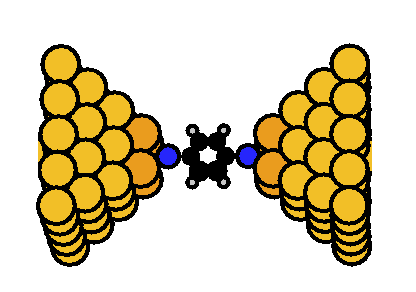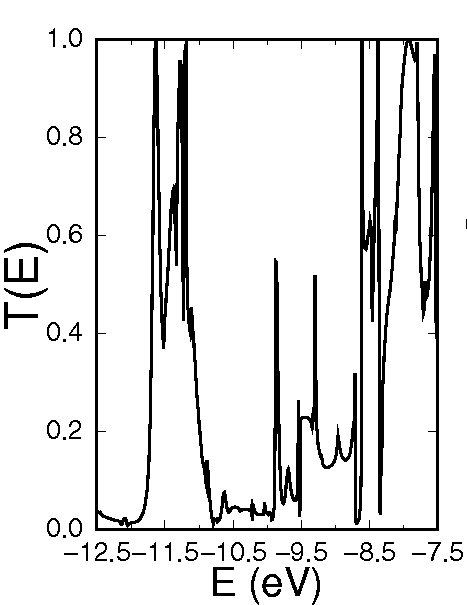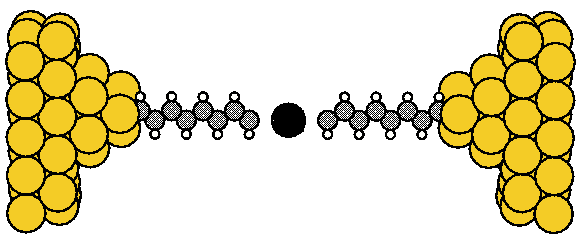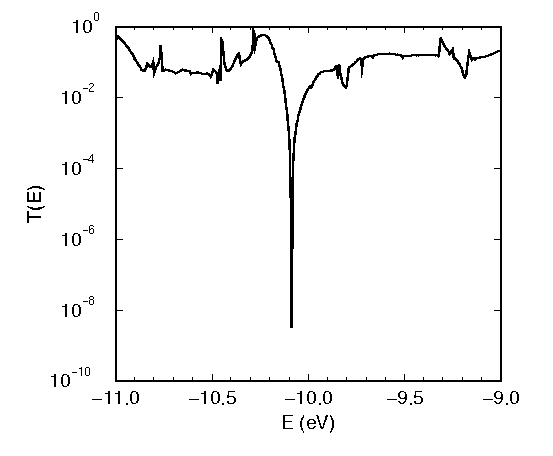Electrical Conductance of Molecular Wires
Eldon Emberly* and George Kirczenow
Simon Fraser
University
This is an abstract
for a presentation given at the
Sixth
Foresight Conference on Molecular Nanotechnology.
The full article is available at http://www.foresight.org/Conferences/MNT6/Papers/Emberly/index.html.
Molecular wires (MW) are the fundamental building blocks for molecular electronic devices. The simplest definition for a MW is a single molecular unit connected to two continuum reservoirs of electrons (usually metallic leads). Modeling electron transport in this coupled system is a complex problem uniting methods from both chemistry and physics. We rely on Landauer theory as the basis for studying the conductance properties of MW systems. This relates the lead to lead current to the transmission probability for an electron to scatter through the molecule via the finite voltage, finite temperature Landauer formula. Two different methods have been developed for the study of this scattering. One is based on a solution of the Lippmann-Schwinger equation and the other solves for the t matrix using Schroedinger's equation. In both methods the chemistry of the molecule and the binding of it to the leads is modeled using the extended Huckel tight binding scheme. Using these two methods we have been able to calculate the electrical conductance of various MW systems and two are discussed below.
The first system to be modeled is a system of current experimental interest which has a MW consisting of 1,4 benzene-dithiolate (BDT) bonded to two gold nanocontacts.1 Two areas of uncertainty in this system are the lead geometry and the bonding of the molecule to the leads. Our methodology has allowed us to calculate the conductance for different geometrical configurations for this system. One of these geometries is shown in Fig. 1.


Fig. 1 Atomic configuration of Au leads bonded to BDT. Transmission probability for the given geometry.
We model the tips using gold clusters to which we bond the BDT. These are then attached to multimode metallic leads. We have found that electron transmission is sensitive to lead geometry and bonding schemes.
The second system we consider highlights an interesting phenomenon that occurs in the electronic transmission of MW systems, namely antiresonances.2 An antiresonance happens when electrons are totally reflected from the MW. This property has also been studied in other mesoscopic systems such as electronic wave guides (stub tuners) and double barrier resonant tunneling (DBRT) devices which act as quantum transistors. What is interesting is that the antiresonance in MW systems arises from a different type of electronic interference effect. We have been able to derive an analytic formula which predicts the energies at which electrons will be perfectly reflected from a MW. Using this formula we have been able to engineer a MW with an antiresonance at a specific energy. This system is depicted in Fig. 2.
 
Fig. 2 Atomic geometry of (111) Au leads connected to C8H8 filter chains and larger "active" molecule. Transmission probability for the given geometry showing strong antiresonance at -10.08 eV.
An important aspect of the system that we have come up with is the use of conjugated chain molecules to act as mode filters. These filter out the many electron modes in the metallic contacts down to one single pi-like mode. The filtering done by these conjugated chains is useful for the antiresonance system, but may also be of use in other MW systems. As is seen in the transmission probability there is a strong drop in transmission at the chosen energy. In general, there is still a lot that needs to be done both experimentally and theoretically to understand the physics and chemistry behind MW's.
References
1 Reed, M. A., C. Zhou, C. J. Muller, T. P. Burgin, and
J. M Tour. (1997) Science 278 p. 252-253.
Conductance of a Molecular Junctions.
2 Kemp, Mathieu, Adrian Roitberg, Vladimiro Mujica, Todd Wanta and Mark A.
Ratner. (1996) J. Phys. Chem. 100 p. 8349-8355. Molecular Wires:
Extended Coupling and Disorder Effects.
*Corresponding Address:
Department of Physics
Simon Fraser University, Burnaby, BC, V5A 1S6
ph: (604) 291-3480, fax: (604) 291-3592, email: [email protected]
|